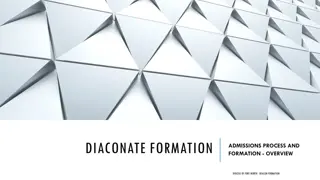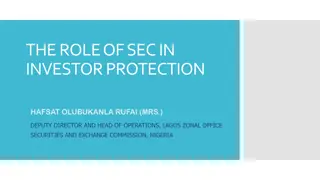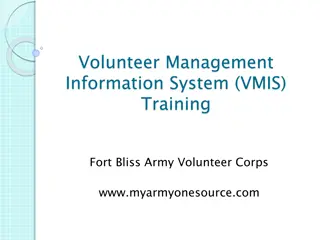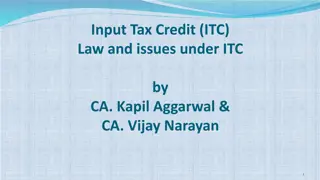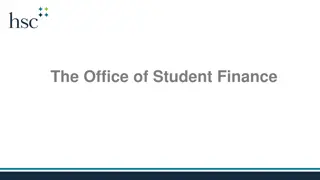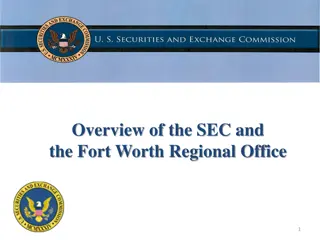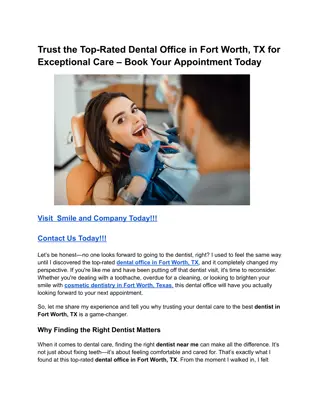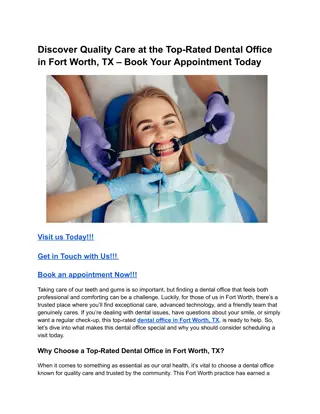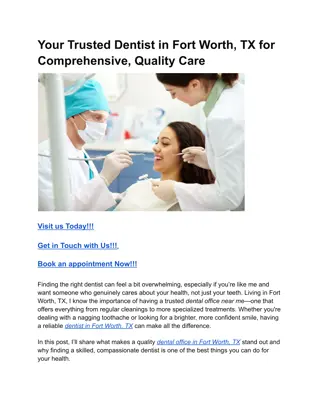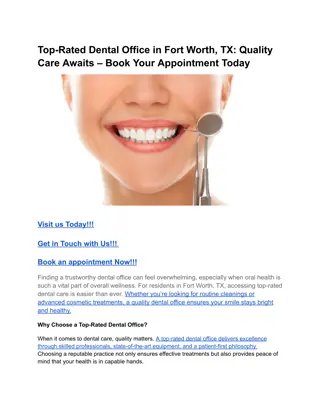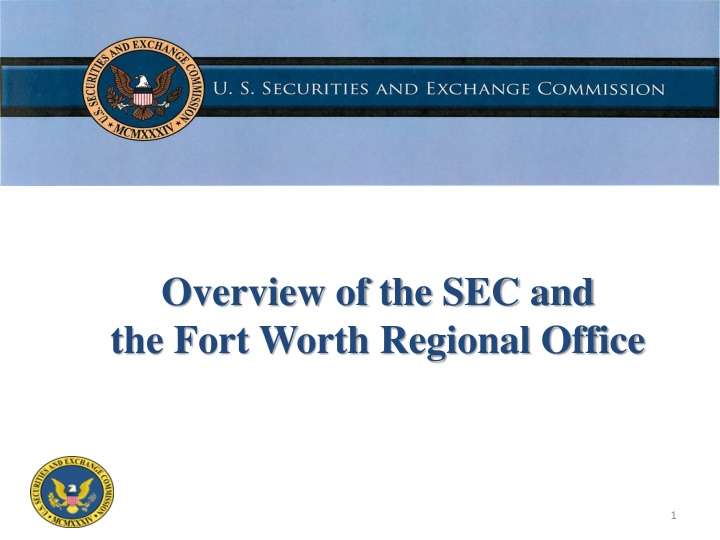
Overview of SEC and Fort Worth Regional Office
The Securities and Exchange Commission (SEC) was established in 1934 to protect investors, maintain fair markets, and facilitate capital formation. Learn about its mission, statutory authority, and commitment to applied ethics in the securities industry.
Download Presentation

Please find below an Image/Link to download the presentation.
The content on the website is provided AS IS for your information and personal use only. It may not be sold, licensed, or shared on other websites without obtaining consent from the author. If you encounter any issues during the download, it is possible that the publisher has removed the file from their server.
You are allowed to download the files provided on this website for personal or commercial use, subject to the condition that they are used lawfully. All files are the property of their respective owners.
The content on the website is provided AS IS for your information and personal use only. It may not be sold, licensed, or shared on other websites without obtaining consent from the author.
E N D
Presentation Transcript
Overview of the SEC and the Fort Worth Regional Office 1
Disclaimer for Marshall Remember: The U.S. Securities and Exchange Commission, as a matter of policy, disclaims responsibility for any private publication or statement by any of its employees. Views expressed herein are those of the presenter and do not necessarily reflect the views of the Commission or other members of the staff of the Commission. 2
Overview of the SEC Created by Congress in 1934 after the Stock Market crash of 1929 The mission is to protect investors, maintain fair, orderly, and efficient markets, and facilitate capital formation Principal Activities: Write rules, regulations, and policies Check for compliance with the rules Take enforcement action if not complying Provide information to the public 3
Overview of the SEC Principal Statutory Authority: Securities Act of 1933 Securities Exchange Act of 1934 Investment Company Act of 1940 Investment Advisers Act of 1940 Sarbanes-Oxley Act of 2000 ( SOX ) Dodd-Frank Wall Street Reform and Consumer Protection Act (2010) 4
An Exercise in Applied Ethics At their core, the federal securities laws were intended by Congress to be an exercise in applied ethics. As the Supreme Court stated almost five decades ago: A fundamental purpose, common to [the federal securities] statutes, was to substitute a philosophy of full disclosure for the philosophy of caveat emptor and thus to achieve a high standard of business ethics in the securities industry . It requires but little appreciation . . . of what happened in this country during the 1920's and 1930's to realize how essential it is that the highest ethical standards prevail in every facet of the securities industry. 5
A Disclosure Regime The laws and rules that govern the securities industry in the United States derive from a simple and straightforward concept: all investors, whether large institutions or private individuals, should have access to certain basic facts about an investment prior to buying it, and so long as they hold it. To achieve this, the SEC requires public companies to disclose meaningful financial and other information to the public. The SEC is not a merits-based regulator: Disclosure provides a common pool of knowledge for all investors to use to judge for themselves whether to buy, sell, or hold a particular security. The key is disclosure of material information. 6
Overview of the SEC Run by five Commissioners Chair Mary Jo White Each appointed by the President No more than three commissioners from same party Workforce of 4200 Smaller than the DC police department Oversees 35,000 + entities: 11,700 investment advisers 9700 mutual funds and ETFs 4500 brokerage firms Stock market in which more than 8.5 billion shares are traded each day Financial statements and corporate disclosures for all public companies 7
Commissions Operations It is the responsibility of the Commission to: interpret and enforce federal securities laws; issue new rules and amend existing rules; oversee the inspection of securities firms, brokers, investment advisers, and ratings agencies; oversee private regulatory organizations in the securities, accounting, and auditing fields; and coordinate U.S. securities regulation with federal, state, and foreign authorities. 8
Commissioners The Securities and Exchange Commission has five Commissioners who are appointed by the President of the United States with the advice and consent of the Senate. Their terms last five years and are staggered so that one Commissioner's term ends on June 5 of each year. To ensure that the Commission remains non-partisan, no more than three Commissioners may belong to the same political party. The President also designates one of the Commissioners as Chairman, the SEC's top executive. 9
Overview of the SEC Five Divisions: Corporation Finance Offerings (issuers) Public companies Enforcement All registrants Investment Management Investment Advisers Investment Companies Trading and Markets Broker-Dealers SRO s Transfer Agents Economic and Risk Analysis 10
Overview of the SEC Eight Offices: Compliance, Inspections and Examinations Investor Education and Advocacy Chief Accountant Secretary General Counsel International Affairs Administrative Law Judges Legislative and Public Affairs 11
Overview of the SEC Eleven Regional Offices: New York Boston Philadelphia Denver Fort Worth Salt Lake Chicago Los Angeles San Francisco Miami Atlanta 12
Overview of the SEC Regional Offices two principal activities: Enforcement Director Andrew Ceresney Deputy Director Stephanie Avakian Investor protection Conducts investigative activities and court litigation Compliance, Inspections, and Examination Director Marc Wyatt Deputy Director Jane Jarco Carries out the National Examination Program for investment advisers, investment companies, broker-dealers, municipal securities dealers, transfer agents, clearing agencies, self-regulatory organizations, municipal advisors 14
The Fort Worth Regional Office Region covers Texas, Oklahoma, Kansas and Arkansas Fastest growing state and three fastest growing metros in US (Austin, Houston and Dallas) 468 NYSE and Nasdaq companies More than 1,000 public reporting companies 64 Fortune 500 companies (2014 rankings) Three of six largest: Walmart, Exxon Mobil, and Phillips 66 Arkansas (7) has second largest concentration of F-500 in our region, behind Texas 15
The Fort Worth Regional Office 119 Total Employees 66 Enforcement staff 41 Attorneys 10 CPA Accountants 10 paralegals 44 Examination staff 26 IA/IC 12 Broker-Dealer 1 Geophysicist on staff 16
Specialized Units SEC has five specialty units, three of which are represented in FWRO FCPA Asset Management Complex Financial Instruments Municipal Securities Market Abuse 18
Key Features of our Investigations Self-contained: Investigate and litigate our own cases Purely civil jurisdiction Can sue in federal court or administratively Broad investigative powers but key limitations imposed by Privacy Act and other acts Specifically authorized to collaborate with DOJ 19
Types of Cases Financial reporting and disclosure Insider trading FCPA Broker-dealer, investment adviser & investment company Market manipulation Offering frauds & Ponzi schemes Affinity frauds, especially religious affinity Oil & gas offerings Very crude to highly sophisticated 20
Financial Reporting and Issuer Disclosures Not as much today Historic drop in restatements/cases SOX worked Internal controls are better Lots of people looking for fraud Whistleblowers Increased penalties Will never go away People are not perfect Short-termism is rampant SOX has not worked as well The market may not be ripe for large scale accounting fraud right now 22
Financial Reporting and Issuer Disclosures Renewed focus post-financial crisis Recent increase in filed actions Gatekeepers directors, accountants, auditors Individuals FRAud Task Force FRAud Group Technical violations and internal controls broken windows Pencils Spreadsheets AQM CIRA AI? Whistleblowers 23
The SEC is a Civil agency Civil Actions: Commission files a complaint with a U.S. District Court Administrative Actions: Administrative Proceeding Process Heard by an Administrative Law Judge (ALJ) Independent of the Commission Outcomes Injunctions requiring audits, accounting for frauds or special supervisory arrangements Monetary Penalties Disgorgement of ill-gotten gains Bar or Suspend an individual from serving as a corporate officer or director Bar an attorney or accountant from practicing before the Commission Cease and Desist Orders Suspensions or revocation of Broker-Dealer or Investment Adviser Registration Censures 24
Remember The SEC is a Civil agency The SEC does not put people in jail! 25
Regional Registrant Demographics The U.S. Securities and Exchange Commission s (SEC or agency) Office of Compliance Inspections and Examinations (OCIE) plays a critical role in protecting investors. OCIE administers the SEC s National Examination Program (NEP) and conducts examinations and oversight of the nation s approximately 27,000 registered entities (registrants). These include about 11,900 investment advisers (IAs), about 10,500 mutual funds and exchange-traded funds, nearly 4,300 broker-dealers, 425 transfer agents, 18 securities exchanges, and self-regulatory organizations such as the Financial Industry Regulatory Authority (FINRA). OCIE examinations of these entities improve industry compliance with Federal securities laws, detect and prevent fraud, inform policy, and identify risks. OCIE is composed of various program areas and operational and administrative offices. The four main program areas are: (1) Office of Investment Adviser/ Investment Company (IA/IC) Examinations; (2) Office of Broker-Dealer Examinations; (3) Office of Clearance and Settlement; and (4) Office of Market Oversight. Additionally, OCIE has a Technology Controls Program responsible for technology control program inspections of registered entities, including clearing agencies and exchanges. Each program area is headed by an Associate Director responsible for setting directives and ensuring consistency across the NEP with respect to the Associate Director s program. As of October 2015, OCIE had over 900 total staff employed at the SEC s Headquarters and its 11 regional offices. As Table 1 shows, in fiscal year (FY) 2015, OCIE conducted almost 2,000 formal examinations of registrants. More than 51 percent of OCIE s FY 2015 examination resources (467 examiners) were allocated to the IA/IC program, accounting for about 69 percent (or 1,358) of the exams conducted. 27
Regional Registrant Demographics Investment Advisers 669 Registered Investment Advisers (6% of all SEC registered advisers) $1.745 trillion in AUM (3% of total AUM of registered advisers) 36% indicate that they manage private funds 42% have custody (including through a related person) 4% are also broker-dealers Broker-Dealers 264 registered BDs (~6% of all SEC registered broker-dealers) 14,003 branch offices (~9% of total) $10 billion in assets 1,007,320 customer accounts held 54,345 associated individuals Other 51 Municipal Advisor Registrants 32 Transfer Agents 29
Examination Process Consists of: 1. 2. 3. 4. 5. Exam Selection Exam Assignment Exam Scope Exam Work Exam Disposition 30
Exam Selection Office of Compliance & Examinations Risk Department in D.C. & Regional Offices Identify firms as High Risk based upon business operations, products, revenues, etc. Identify firms as part of National Sweeps Identify newly registered firms or firms that have never been examined Identify firms through Tips, Complaints, and/or Referrals from other SEC offices, other agencies, or the public Assigned to Regional Offices where firm is located Regional offices select firms from this list 31
Exam Assignment Associate and Assistant Regional Directors break up the firms they have selected (i.e. IA/IC or BD/TA) Exam Managers are then assigned to oversee the completion of the exam Exam Team created based upon knowledge level of products offered or sold by the firm, and staff availability Exam Team consists of: Exam Manager Lead Examiner Supporting/Assisting Examiner(s) depending on size of firm, could be multiple supporting examiners 32
Exam Scope Determining Scope Initially based upon risks identified during selection process May be extremely focused (if TCR, or Sweep) May be pretty broad if firm has never been examined before Scope will identify focus areas for the exam team Focus area can be adjusted during the pre-exam and/or on-site fieldwork stages of the exam. 33
Exam Work Three Stages Pre-Fieldwork Fieldwork (on-site) Post-Fieldwork 34
Pre-Fieldwork Review databases, filings, past examination reports, past enforcement actions, financials, registrations, complaints, etc. Review firm websites, news articles, and any other internet search results related to the firm At this point, we could adjust scope if needed based upon pre-exam review We may also review modules related to the scope or focus areas of the exam (modules are references/guides that aid in performing specific reviews) We may also review no-action letters or any interpretive releases related to any of the focus areas of our scope 35
Pre-Fieldwork (contd) Notify Firm We typically notify the firm during the pre- fieldwork process of the upcoming examination (usually a week to two weeks before the on-site fieldwork begins) During the notification call with the firm, we gather some general info about the firm (business activities, types products sold, number of employees, number of customers, fees charged, etc.) Following the call we send the firm a document request list. 36
Fieldwork We meet on-site with firm personnel and discuss the firm s operations, structure, policies and procedures, and other topics as they may relate to the focus areas of the exam. Remainder of the week is spent reviewing the requested documentation and meeting additional firm personnel. During this stage, we may make additional requests if necessary and review 37
Post Fieldwork Reviews continue back in the office. The exam staff typically spends a few additional weeks finishing reviews, and researching various regulatory issues (securities laws, interpretive guidance, and no-action letters to support any/all findings identified during the exam). Memorialize exam work in an internal exam report. The report typically identifies the focus areas of the exam along with the reviews performed, and any violations of securities laws identified during the exam. 38
Exam Disposition Generally three types of outcomes to an exam: 1. No findings resulting No Further Action Taken (rarest outcome) 2. Deficiency Letter A letter to the firm that identifies all of the areas where we found that the firm failed to comply with Securities Laws. Deficiency Letters require a timely response from the firm regarding corrective action Also, provides opportunity to present facts if they feel our findings are incorrect. 3. The exam is referred to another SEC division or separate agency SEC Enforcement Referral SRO Referral (FINRA, CFTC, etc.) State Securities Board Referral (TSSB) Other SEC Offices or other Divisions (Regional, TM, CorpFin, etc.) 39
Ethics and Compliance Difference between E and C Why care? Why the regulators care? What you can do 41
Ethics and Compliance Compliance means conforming to a rule, such as a specification, policy, standard or law. Regulatory compliance describes the goal that organizations aspire to achieve in their efforts to ensure that they are aware of and take steps to comply with relevant laws and regulations. Ethics deals with the basic concepts and fundamental principles of what is good and bad behavior and what is morally right or wrong. 42
Compliance Lesson: Space Shuttle Tragedies stricter regulatory oversight. When the National Aeronautics and Space Administration has a breakdown in its processes, the results can be deadly, as was the case when the space shuttles Challenger and Columbia exploded in two separate incidents. There are lessons to be learned by compliance officers from the two disasters, said former astronaut Garrett Reisman, who spent more than 100 days on the International Space Station. The 1986 Challenger explosion occurred after an O-ring seal failed during liftoff, costing the seven astronauts on board their lives. A special commission created to investigate the accident cited NASA s organizational culture and decision-making processes as key reasons for the disaster. When Columbia exploded in 2003, the cause was some foam panels that broke off the rocket something engineers had seen in previous flights and voiced concerns over. But their fears were dismissed by higher-ups in the organization. Deadline pressures, doing things wrong without suffering consequences, disregarding data and facts to make decisions based on opinions and beliefs, and failing to foster an environment of open communication where dissent is valued combined to kill 14 astronauts in the two explosions, Mr. Reisman said and those same failures can leave companies vulnerable to compliance disasters of their own. Just because you get away with something over and over again doesn t mean it s not a danger, Mr. Reisman said this week at the Society of Corporate Compliance and Ethics conference in Las Vegas. You have to have deadlines but when they get unrealistic, that s when your spidey sense as a compliance officer should come out, because that s the time when someone may start to cut corners. Both tragedies highlighted a failure of critical information to reach people who would have had the authority to delay the missions until the concerns could be addressed, he said, and the lessons show why leaders at every level of an organization have to listen to what the people below them are saying, he said. Critical information was available but never reached decision makers. Ultimately, the astronauts were told they had nothing to worry about, said Mr. Reisman. The people with concerns were told to prove there was a problem when the approach should have been to prove to me it s safe, he said. None of us is as dumb as all of us. Decide based on facts and data, not opinions and beliefs. Compliance officers, Mr. Reisman said, would be well served to focus on the things that are important and to resist the temptation to go after the low-hanging fruit those risks that are easy. When most companies have a compliance breakdown, the consequences can include fines, penalties and 43
Ethics and the Federal Securities Laws Ethics is not important merely because the federal securities laws are grounded on ethical principles. Good ethics is also good business. Treating customers fairly and honestly helps build a firm s reputation and brand, while attracting the best employees and business partners. Conversely, creating the impression that ethical behavior is not important to a firm is incredibly damaging to its reputation and business prospects Another way of saying this is that a corporate culture that reinforces ethical behavior is a key component of effectively managing risk across the enterprise. (Carlos diFlorio, Director of the SEC's Office of Compliance Inspections and Examinations, 2010-2013) 44
Audience Poll #1 I rank my company s CCO or CECO role as: a) Very well structured an A+ b) Good structure, but lacking a few bells & whistles c) Fair just the basics, needs more development d) Below average not that well structured e) Not sure 45
Essential Features EMPOWERED SEAT AT THE C TABLE INDEPENDENT STRONG CECO SUFFICIENT RESOURCES LINE OF SIGHT 46
Audience Poll #2 Of the 5 key features, the one I feel is missing most in my company s CECO role is: a) Empowerment b) Independence c) Seat at the table d) Line of sight e) Resources f) None are missing - our CECO role is awesome! 47
Every Firm Has Exactly the Compliance Program it Wants 48
Learning Objectives At the end of this session, the participants should be able to: Describe the organizational structure of the SEC Identify the types of cases investigated by the SEC List the investigative tools used by the SEC in its enforcement efforts Summarize the SEC examination process 49
Questions 50


